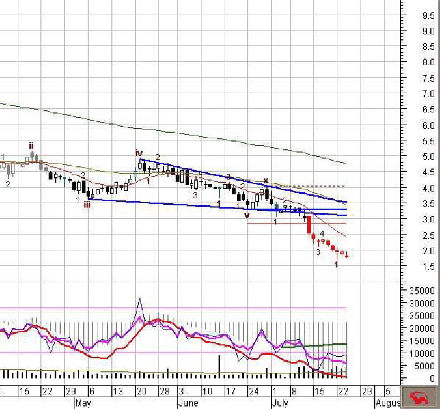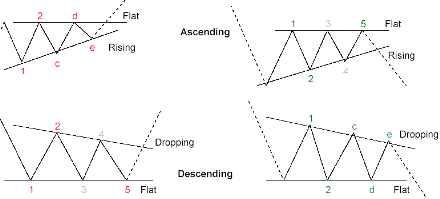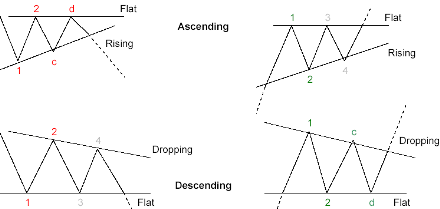AlphOmega has its own triangle pattern indicators. Based on the Elliott Waves methodology, it will detect converging or diverging triangles of various sensitivities, display the whole triangle at its fourth peak or trough. Coupled with these indicators is a twin that will display a triangle from the date we select if the date matches the fourth point of a triangular pattern. Converging triangles are named as such because the two lines, peak to peak and trough to trough, are going to cross at some point in the future. To trade such patterns involves more skill than trending patterns; the triangle pattern usually takes place during a consolidation period.
Because the lines are getting closer together, the price range is narrowing. So we can either trade the last fifth wave that could be the breakout or the unusual fifth wave that turns around before breaking in the other direction. To do this type of trade we must use a stop entry. In other words, a buy stop will allow us to enter a trade only if the price goes up past our stop and the reverse for a sell stop. The breakout means that we expect the trend to resume its former direction! Let's look at the chart to understand the forces at play.

Fig. 62
The triangle is automatically and clearly outlined by the blue lines joining the peaks and troughs of the pattern. Elliott says that a triangle should contain 5 segments, no more no less. The dark red roman labels are at the peaks and troughs for this normal sensitivity triangle starting at end of wave ii. The detection of the pattern occurs at the last peak or trough of the pattern, in this case at the trough labelled X. The indicator will display from that moment the triangle as we see it. Note that if the triangular pattern is almost horizontal or flat, the expert will display specific labels that will be discussed later.
From a trading perspective, the problem really starts with the fifth segment; most of the time the last segment will be the one that breaks out of the triangle, while at other times it will bounce one last time against the wall before breaking out. For this reason, the triangle is difficult to trade. In our chart, the fifth segment broke out of the triangle which is very common. The safest way to deal with it, is to wait for the breakout from the triangle (here at $3.25) before taking a position. Then with appropriate stop loss and parabolic stops, we can make a profitable trade. This pattern (converging triangle) is very similar to the Wolf Wave and the difference is in the fifth segment where the Wolf Wave will touch or penetrate a little the wall to break out the other way. With the indicators come the explorations for various sensitivities. The whole set is easier to use once we understand the nomenclature.
Of all the accepted rules for Elliott, there is one aspect where AlphOmega does not follow the pack. When a triangle, flag or pennant is taking place, a sequence of waves takes place where the labels should run from a to e, w, y and z. These waves do not follow at times our internal definition of a pattern, which is wave three does not top wave 1, wave 5 does not top wave 3. With version 4.3 AlphOmega has created a special set of symbols that will start displaying a converging triangle from wave 3 and the letters c, d and e will be used. Here is how it will look.

Fig. 63
As we can see, if the impulsions peak at exactly the same resistance level or troughs at the same support level, the count is correct. Otherwise the count is flawed and we will have waves 1 and 2 followed by a gray wave 3 or a “c”.

Fig. 64
The pattern above is different and I have encountered it more often than the previous pattern. The important thing to remember about them is that they usually exit the triangle in the same direction that they entered. The analysis of triangles is difficult because the confusion with other valid patterns can lead us into different conclusions and we will know the true one only when it is completed. There is still a triangular pattern we have not dealt with, the broadening or diverging triangle. It is very rare and you would get a bunch of alternating red and green waves 1.
Next: More on Interpretation of Labels
Summary: Index